Temple of Concordia, Agrigento
| Temple of Concordia | |
|---|---|
|
| |
| Alternative names | Temple of Concord |
| General information | |
| Architectural style | Ancient Greek |
| Location | Agrigento, Sicily, Italy |
| Completed | c. 440-430 BC[1][2] |
| Renovated | 1785 |
| Affiliation | Christian church (6th century-1785) |
| Height | 8.93 m (29.3 ft)[3] |
| Dimensions | |
| Other dimensions | 39.42 m × 16.92 m (129.3 ft × 55.5 ft)[1][4] |
The Temple of Concordia (Italian: Tempio della Concordia) is an ancient Greek temple in the Valle dei Templi (Valley of the Temples) in Agrigento (Greek: Akragas) on the south coast of Sicily, Italy. It is the largest and best-preserved Doric temple in Sicily[5] and one of the best-preserved Greek temples in general,[1] especially of the Doric order.[2][3]
Overview
The temple was built c. 440–430 BC.[2][3][4] The well-preserved peristasis of six by thirteen columns[1] stands on a crepidoma of four steps (measuring 39.42 m × 16.92 m (129.3 ft × 55.5 ft),[1][4] and 8.93 m (29.3 ft) high)[3] The cella measures 28.36 m × 9.4 m (93.0 ft × 30.8 ft).[4] The columns are 6 m (20 ft) high[6] and carved with twenty flutes and harmonious entasis (tapering at the tops of the columns and swelling around the middles).
It is constructed, like the nearby Temple of Juno, on a solid base designed to overcome the unevenness of the rocky terrain. It has been conventionally named after Concordia, the Roman goddess of harmony, for the Roman-era Latin inscription found nearby, which is unconnected with it.[1][2]
The temple was converted into a Christian basilica in the 6th century dedicated to the apostles Peter and Paul by San Gregorio delle Rape, bishop of Agrigento and thus survived the destruction of pagan places of worship.[2][4][6] The spaces between the columns were filled with walling, altering its Classical Greek form. The division between the cella, the main room where the cult statue would have stood in antiquity, and the opisthodomos, an adjoining room, was destroyed, and the walls of the cella were cut into a series of arches along the nave.[2] The Christian refurbishments were removed during the restoration of 1785.[1] According to another source, the Prince of Torremuzza transferred the altar elsewhere and began restoration of the classic building in 1788.[4]
According to authors of a 2007 article, it is "apart from the Parthenon, the best preserved Doric temple in the world."[7]
Gallery

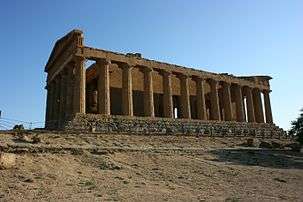
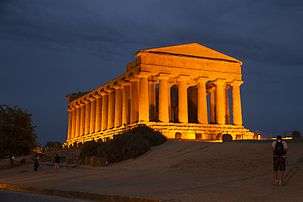
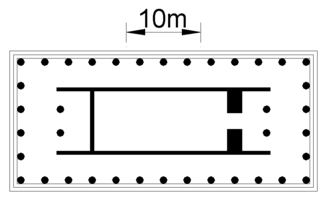 Floorplan of the temple
Floorplan of the temple
 View of the Temple of Concord at Agrigentum by Charles Gore (1777)
View of the Temple of Concord at Agrigentum by Charles Gore (1777) A View at Girgenti in Sicily with the Temple of Concord and Juno by Charles Lock Eastlake (c. 1818)
A View at Girgenti in Sicily with the Temple of Concord and Juno by Charles Lock Eastlake (c. 1818)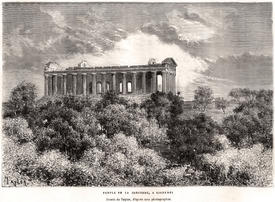 Temple of Concord at Girgenti, a wood engraved print (c. 1885)
Temple of Concord at Girgenti, a wood engraved print (c. 1885).jpg) Temple of Concord, Girgenti by William Henry Goodyear (1895)
Temple of Concord, Girgenti by William Henry Goodyear (1895)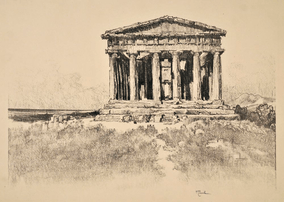 The Temple by the Sea by Joseph Pennell (1913)
The Temple by the Sea by Joseph Pennell (1913)
References
- 1 2 3 4 5 6 7 Bäbler, Balbina (2013). "Acragas". In Wilson, Nigel. Encyclopedia of Ancient Greece. Routledge. p. 8. ISBN 9781136788000.
- 1 2 3 4 5 6 Bennett, Michael J.; Paul, Aaron J.; Iozzo, Mario (2002). Magna Graecia: Greek Art from South Italy and Sicily. Hudson Hills. pp. 43–46. ISBN 9780940717718.
- 1 2 3 4 De Angelis, Franco (2016). Archaic and Classical Greek Sicily: A Social and Economic History. Oxford University Press. p. 115. ISBN 9780195170474.
- 1 2 3 4 5 6 "la Valle dei Templi di Agrigento" (PDF). regione.sicilia.it. Regione Siciliana. p. 21. Archived from the original (PDF) on 19 July 2016.
- ↑ Egan, James (19 April 1981). "Sicily in spring: a flowering isle wreathed in antiquity". The New York Times.
...the Temple of Concordia, the most massive and best-preserved Doric temple in Sicily.
- 1 2 "Il Tempio della Concordia". comune.agrigento.it (in Italian). Commune di Agrigento.
- ↑ Barone et al. 2007, p. 49.
- Bibliography
- Barone, P. M.; Graziano, F.; Pettinelli, E.; Corradini, R. Ginanni (2007). "Ground-penetrating radar investigations into the construction techniques of the Concordia Temple (Agrigento, Sicily, Italy)". Archaeological Prospection. 14 (1): 47–59.
- Standish, Frank Hall (1837). The shores of the Mediterranean. Edward Lumley. pp. 132–133.
Coordinates: 37°17′23″N 13°35′32″E / 37.28972°N 13.59222°E

